Black and white birds are stunning creatures that are found across the world. The contrast of black and white feathers is a unique feature that distinguishes these birds from others.
These birds have evolved and adapted to their environments to survive and thrive. Their striking appearances make them fascinating to observe in nature. In this article, I will explore the different types of black and white birds, their characteristics, habitats, and behaviors.
Whether it’s the majestic bald eagle or the charming black and white warbler, these birds are a treat to observe and study.
1. Gulls
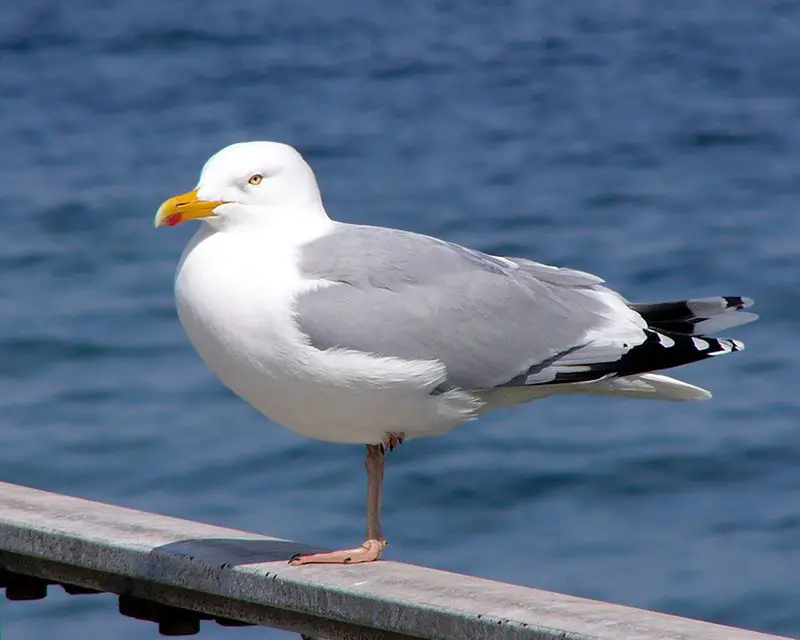
Gulls are a type of seabird in the family Laridae found worldwide. They are highly adaptable, often seen soaring above shorelines or near bodies of water.
Gulls have strong wings and long bills and vary greatly in size, colouration and behaviour from one species to another.
Some gull species feed on fish while others scavenge for food such as insects, small mammals or discarded human refuse.
Despite their different dietary habits they all share common traits including webbed feet which enable them to swim gracefully through the water after prey items like crabs or molluscs.
Gulls generally nest close to the shoreline where there is an abundance of available food sources making them excellent hunters that can live comfortably both on land and at sea.Scientific classification:
| Kingdom | Animalia |
| Phylum | Chordata |
| Class | Aves |
| Order | Charadriiformes |
| Suborder | Lari |
| Family | Laridae Rafinesque, 1815 |
Also Featured In: Most Common Birds in China, Birds You’ll Find in the Sea
2. Black-Capped Chickadee

The black-capped chickadee is a small and cheerful songbird found in deciduous and mixed forests across North America. It has an iconic black cap, white cheeks, gray back and wings with whitish bars on them.
The underparts are usually light colored or greyish brown. This species is well adapted to cold winters as it can reduce its body temperature by up to 8°C while roosting at night; this helps save energy during the colder months of the year.
It feeds mainly on insects but also eats seeds, fruits and suet from bird feeders when available.
Black-capped chickadees are popular birds among backyard visitors due to their sociable nature – they often establish lifelong partnerships with one another for breeding purposes.
Furthermore, they have been designated as state birds of Massachusetts and Maine in USA plus New Brunswick in Canada – a testament to how beloved these little avian friends truly are.Scientific classification:
| Kingdom | Animalia |
| Phylum | Chordata |
| Class | Aves |
| Order | Passeriformes |
| Family | Paridae |
| Genus | Poecile |
| Species | P. atricapillus |
Also Featured In: Most Common United States Birds, Most Common Winter Birds
3. Eastern Towhee
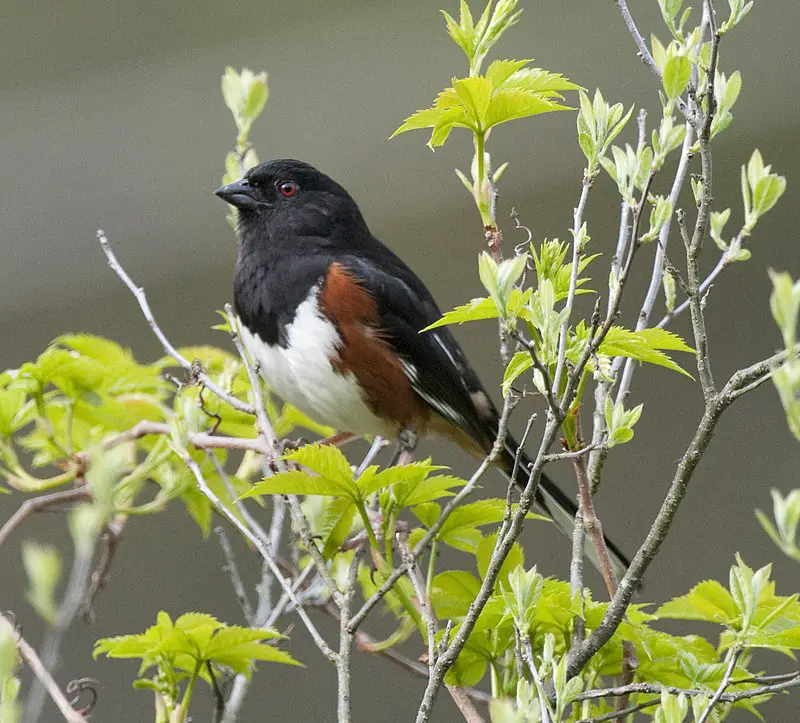
The Eastern Towhee is a large New World sparrow, native to brushy areas of eastern North America. These birds have distinct black and white markings, with chestnut brown underparts.
They nest either low in bushes or on the ground beneath shrubs. Northern towhees are known for migrating south during the winter months.
In recent decades, taxonomy debates have left some questioning whether this bird should remain its own species or be grouped together with the Spotted Towhee as one species — Rufous-sided Towhee.
This lively songbird has a bubbly personality and can often be seen hopping around on branches looking for food such as insects, fruits and seeds.Scientific classification:
| Kingdom | Animalia |
| Phylum | Chordata |
| Class | Aves |
| Order | Passeriformes |
| Family | Passerellidae |
| Genus | Pipilo |
| Species | P. erythrophthalmus |
Also Featured In: Birds Live in Arkansas, Birds that Live in Mississippi
4. Indian Paradise Flycatcher
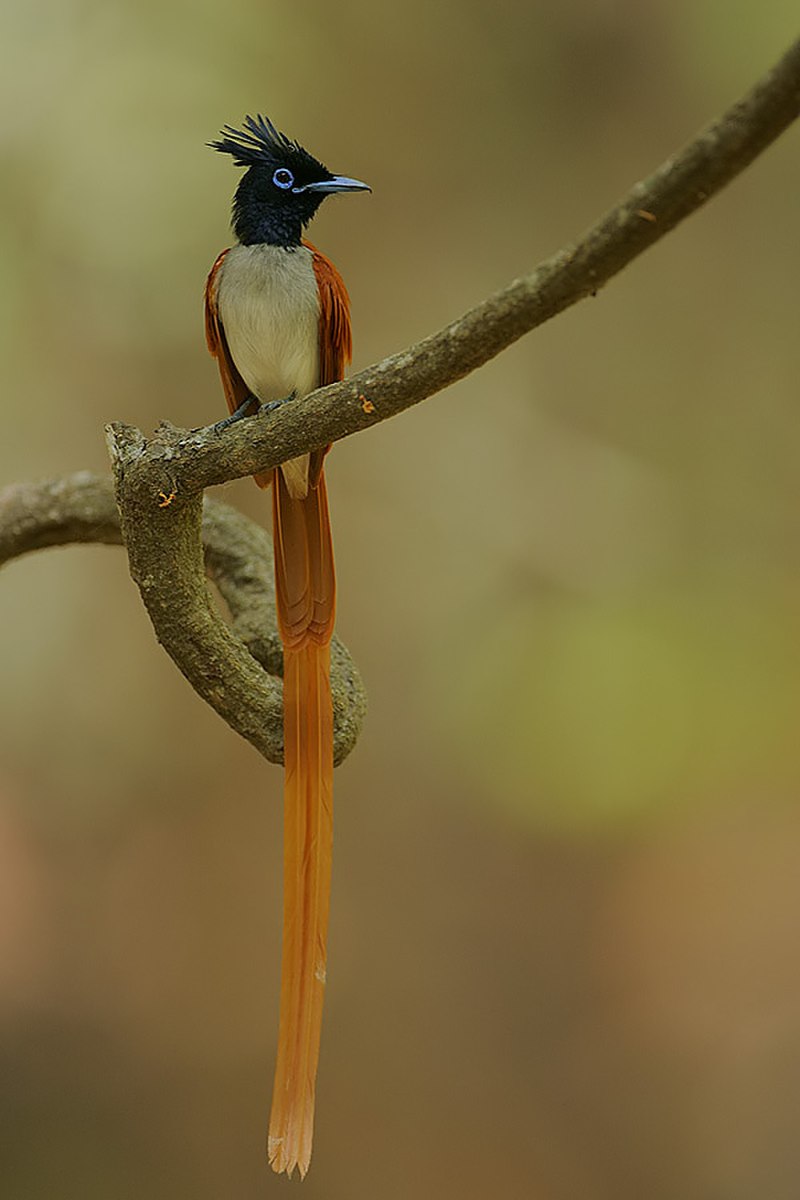
The Indian paradise flycatcher is a beautiful bird native to Asia. It has an overall black and rufous plumage, but the males have elongated central tail feathers that really stand out.
This species is considered stable globally, so it is listed as Least Concern on IUCN’s Red List of Threatened Species.
The range of this passerine extends from India in the South Asian subcontinent all the way up to Central Asia and Myanmar.
Despite its beauty, sadly these birds are also threatened by loss of habitat due to urbanization and deforestation caused by humans- we must do our best to protect them.Scientific classification:
| Kingdom | Animalia |
| Phylum | Chordata |
| Class | Aves |
| Order | Passeriformes |
| Family | Monarchidae |
| Genus | Terpsiphone |
| Species | T. paradisi |
Also Featured In: Native Pakistani Birds, Native Birds of Kazakhstan
5. Black-Necked Stilt
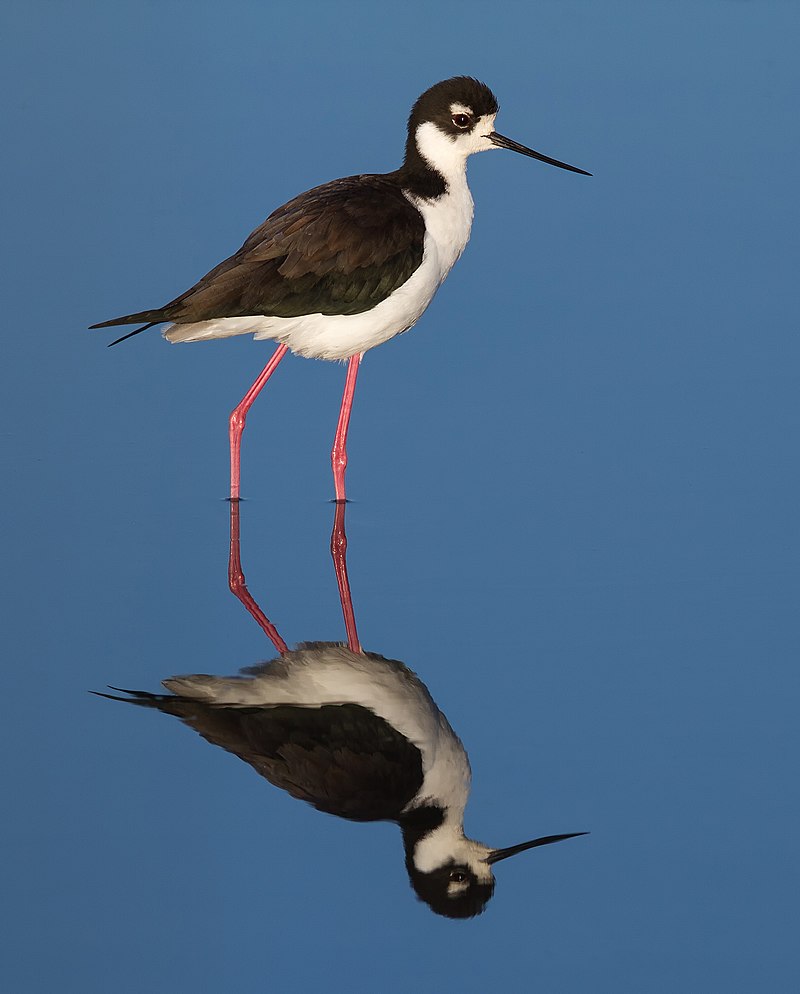
The Black-necked Stilt is an elegant shorebird that can be found from the coastal areas of California to Florida, then south through Central America and Brazil.
It has black upperparts contrasted by long white wings with a glossy sheen. Its striking red eyes are set against its white facial mask while its legs are bright pinkish in coloration.
The Haematopus mexicanus species inhabits marshy wetlands and brackish lagoons where it feeds on insects, crustaceans, small amphibians and fish which they catch using their slender bill or chase after them as they run across the surface of water or mudflats.
This bird typically nests near shallow waters but will use any habitat type if food resources are available nearby making it a highly adaptable species well suited for human altered habitats such as rice fields and sewage ponds.Scientific classification:
| Kingdom | Animalia |
| Phylum | Chordata |
| Class | Aves |
| Order | Charadriiformes |
| Family | Recurvirostridae |
| Genus | Himantopus |
| Species | H. mexicanus |
Also Featured In: Beautiful Brazilian Birds, Phoenix Birds You Should Know
6. Oriental Magpie-Robin
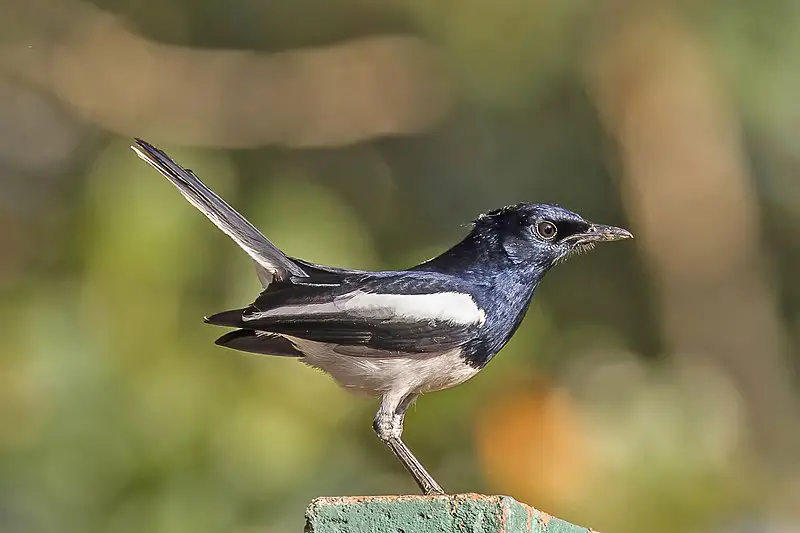
The Oriental magpie-robin is a beautiful passerine bird found across the Indian subcontinent and parts of Southeast Asia.
It can be easily identified by its black and white plumage, long tail that it holds upright while perched or foraging on the ground.
They are known to sing melodiously which makes them popular as cage birds in many countries.
These birds feed mainly on insects but also consume fruits, berries and nectar from flowers during certain times of the year.
Their population numbers have been declining due to destruction of their natural habitats like deforestation.
However, conservation efforts have seen some success in recent years with more areas being set aside for protection and preservation.Scientific classification:
| Kingdom | Animalia |
| Phylum | Chordata |
| Class | Aves |
| Order | Passeriformes |
| Family | Muscicapidae |
| Genus | Copsychus |
| Species | C. saularis |
Also Featured In: Most Common Types of Bangladeshi Birds, Birds that Commonly Found in Bali
7. Herons
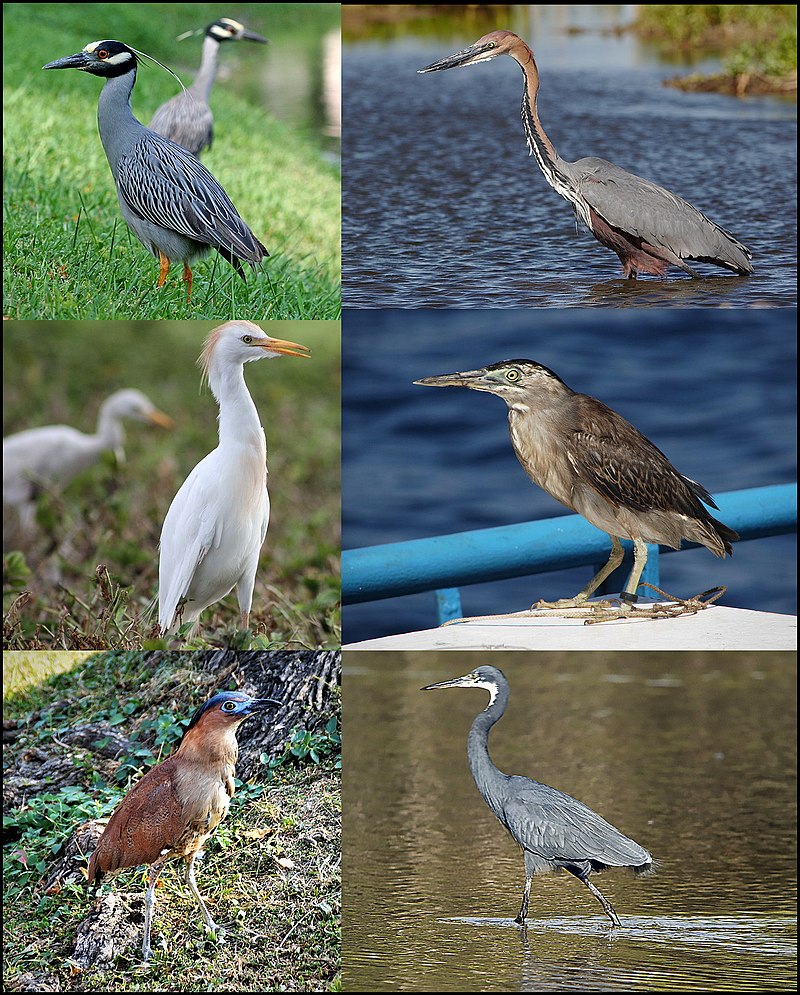
Herons are graceful and elegant birds belonging to the family Ardeidae, with 72 distinct species.
They have long legs and necks that are well-adapted for wading in shallow water like streams or ponds.
Herons can be found near freshwaters as well as along coastal areas worldwide.
Some of these species may also be referred to as egrets, bitterns or zigzag heron/bittern because they belong to certain genera such as Botaurus and Ixobrychus respectively.
These birds stand tall when searching for food by standing still in a shallow body of water while waiting patiently until prey appears before quickly capturing it with their sharp bills.Scientific classification:
| Kingdom | Animalia |
| Phylum | Chordata |
| Class | Aves |
| Order | Pelecaniformes |
| Suborder | Ardei |
| Family | Ardeidae Leach, 1820 |
Also Featured In: Water Birds Live around Us, Famous Paintings Birds
8. Ducks
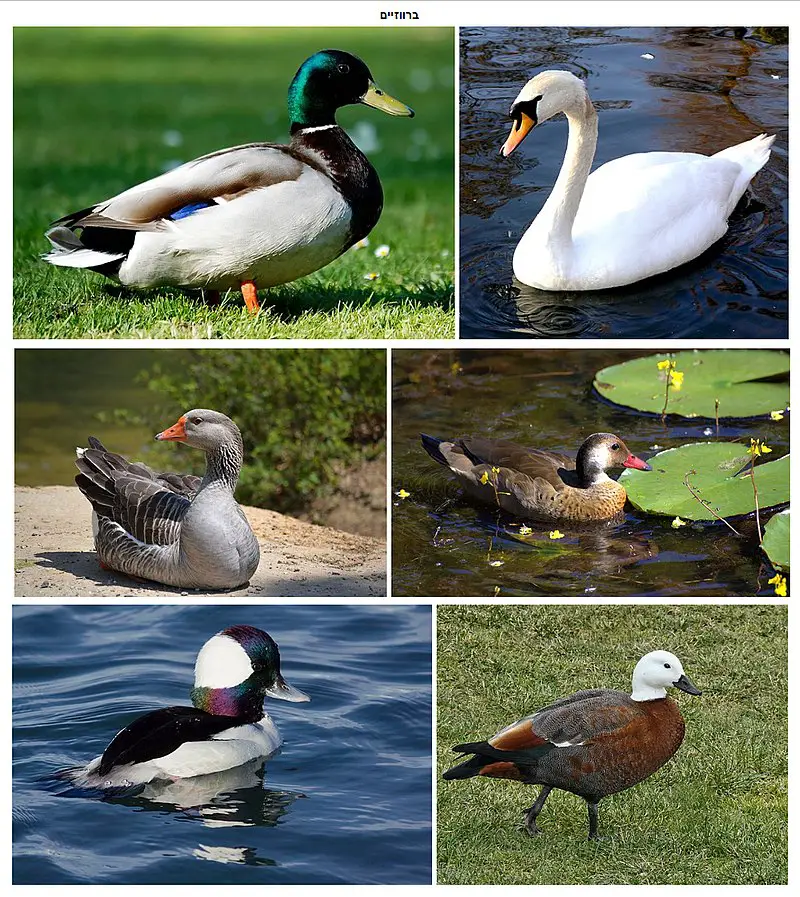
Ducks are water birds belonging to the family of Anatidae. They have a worldwide distribution except Antarctica and are highly adapted for swimming, floating on water surface or in shallow depths.
Ducks come in various sizes ranging from small teals to large swans with around 174 species found across 43 genera.
Their feathers make them waterproof enabling ducks to stay afloat even in stormy waters while their webbed feet allow them to swim gracefully underwater.
Ducks usually feed by filtering food items such as insects, molluscs and crustaceans through their bills but some also graze on land vegetation like grasses & grains depending upon availability of resources at different locations they inhabit.Scientific classification:
| Kingdom | Animalia |
| Phylum | Chordata |
| Class | Aves |
| Order | Anseriformes |
| Suborder | Anseres |
| Superfamily | Anatoidea |
| Family | Anatidae Leach, 1820 |
Also Featured In: Turkey Birds You Should Know, Birds of Sweden
9. Accipitridae
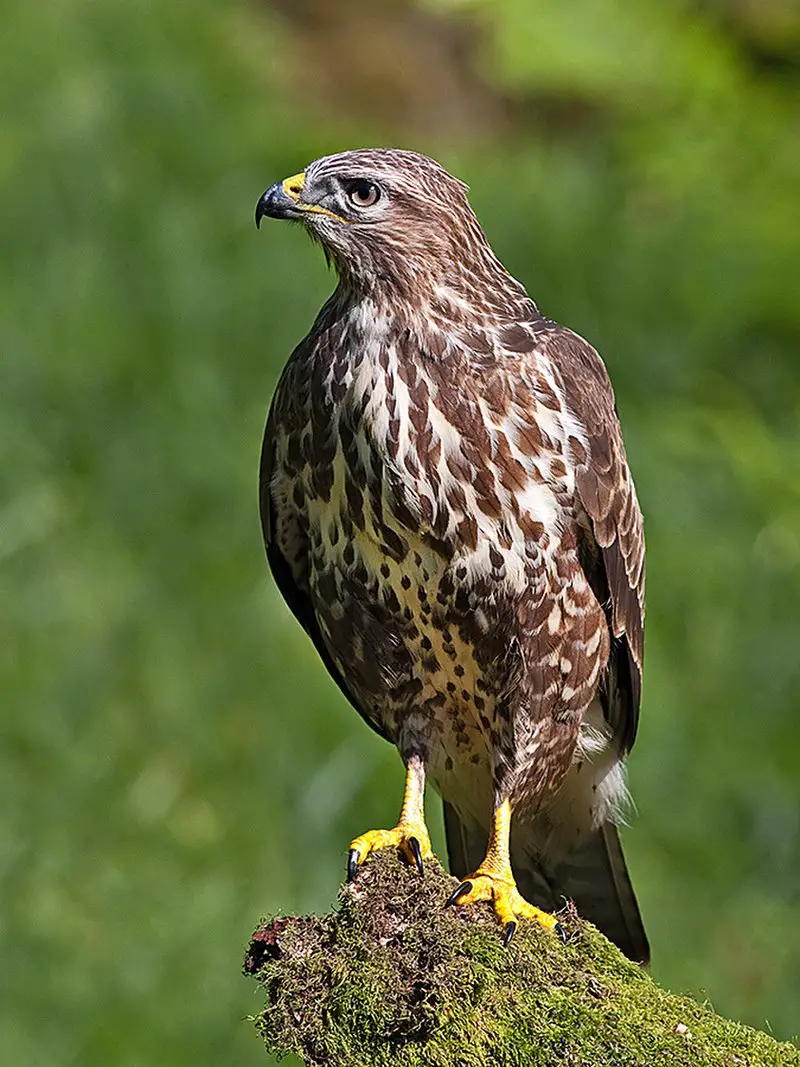
Accipitridae birds are a diverse family of raptors ranging in size from small to large. They have powerful hooked beaks which they use for hunting and tearing apart their prey, such as insects, medium-sized mammals and carrion.
Some species even feed on fruit. These birds can be found all over the world, making them an incredibly successful group of predators.
Accipitridae are adaptable hunters with keen eyesight that helps them spot potential meals from far away distances.
Their sharp talons assist them in grasping onto their victims while feeding or defending themselves against enemies.
Not only do these avian creatures provide us with visual beauty but also help keep our ecosystems healthy by keeping pest populations under control.Scientific classification:
| Kingdom | Animalia |
| Phylum | Chordata |
| Class | Aves |
| Order | Accipitriformes |
| Family | Accipitridae Vieillot, 1816 |
Also Featured In: Italian Birds You Should Know, African Birds
10. Passerine
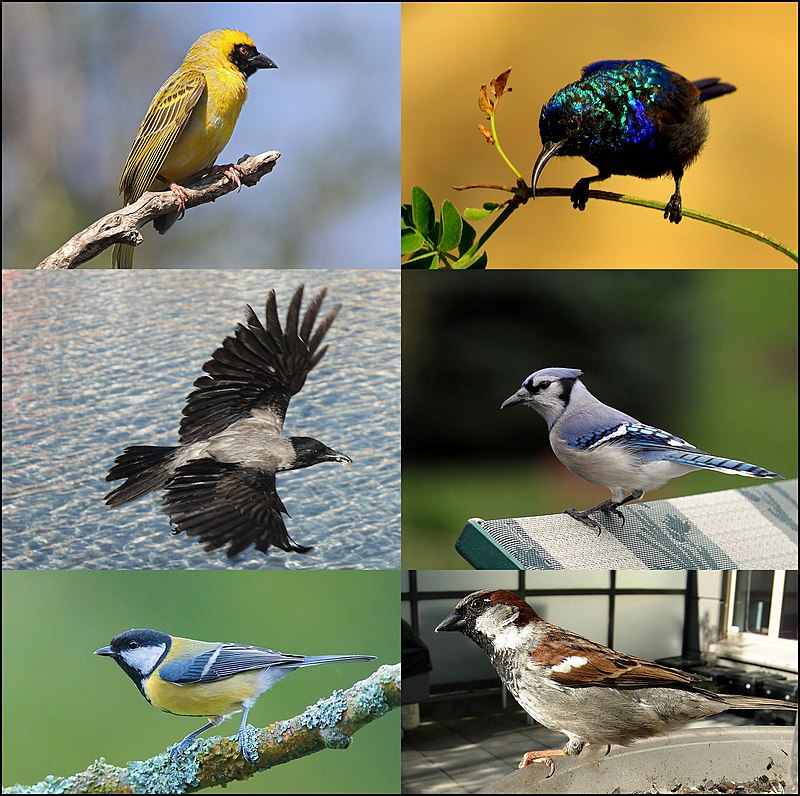
Passerines are a vast order of birds, comprising more than half the species in existence. Many familiar garden and woodland species fall into this category such as sparrows, blackbirds, finches and warblers.
They can be recognised by their arrangement of toes; three pointing forward with one back which helps them perch on branches or wires.
Passerines range from tiny wrens to large crows and have adapted to inhabit many environments around the world including forests, mountainsides and deserts.
They feed mainly on insects but some also consume fruit and seeds depending on their diet preferences.
Their diversity is truly remarkable from vibrant coloured tropical parrots to drab winter thrushes – making passerine birds an integral part of our natural heritage.Scientific classification:
| Kingdom | Animalia |
| Phylum | Chordata |
| Class | Aves |
| Clade | Psittacopasserae |
| Order | Passeriformes Linnaeus, 1758 |
Also Featured In: Egyptian Birds, Most Common Nature Birds
11. White Wagtail
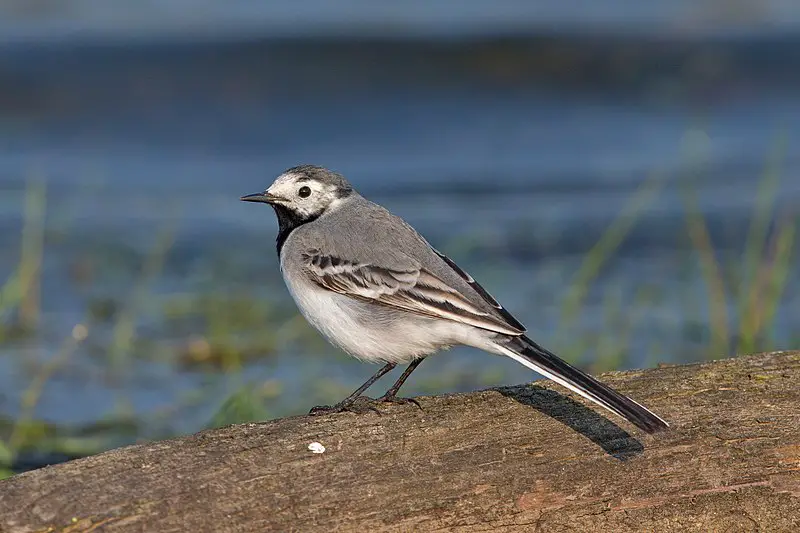
The White Wagtail is a small passerine bird that belongs to the Motacillidae family, which includes pipits and longclaws. This species breeds in Europe, Asia Palearctic and North Africa.
It has also been seen as a scarce breeder in Alaska. Those living in mild climates are found year-round but others migrate south for winter months to Africa.
In Ireland and Great Britain it’s known for its darker subspecies called Pied Wagtails with their distinctive white heads, grey backs and yellow breasts.
They feed on insects such as flies, beetles or spiders by wagging their tail up & down while they walk along surfaces like tree trunks or walls looking out for prey – hence receiving this name.
To attract mates they sing melodic songs from high perches too.Scientific classification:
| Kingdom | Animalia |
| Phylum | Chordata |
| Class | Aves |
| Order | Passeriformes |
| Family | Motacillidae |
| Genus | Motacilla |
| Species | M. alba |
Also Featured In: Common Slovakian Birds, Birds of Latvia
12. Tit
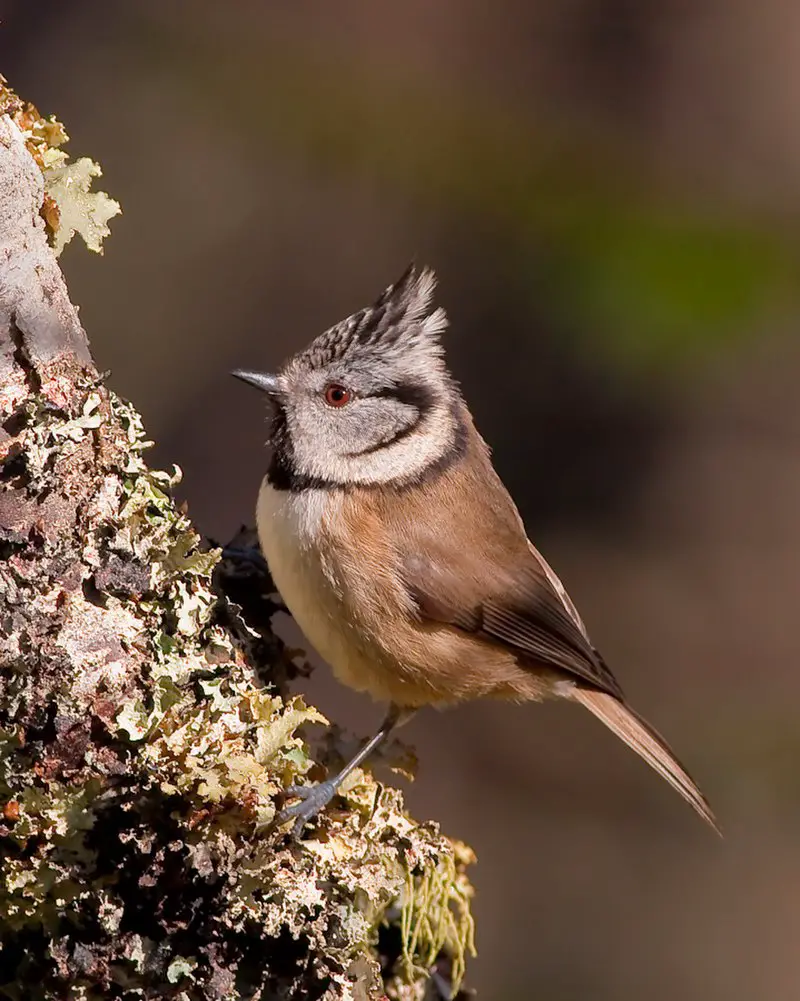
Tit birds are small passerine birds belonging to the family Paridae, found mainly in Northern Hemisphere and Africa.
These active little birds can be seen singing sweet songs throughout the day or scavenging for food at feeders.
They have short, stout bills which they use to crack open seeds and nuts with ease. Tit species range from chickadees to titmice; all of them sport a distinctive black head cap that stands out against their pale grey bodies.
Their bright eyes allow them excellent vision while searching for food – even on gloomy days when other predators may not see as well.
Tits are an important part of any healthy ecosystem and provide many ecological services such as insect control and seed dispersal.Scientific classification:
| Kingdom | Animalia |
| Phylum | Chordata |
| Class | Aves |
| Order | Passeriformes |
| Infraorder | Passerida |
| Family | Paridae Vigors, 1825 |
Also Featured In: Birds of United Kingdom, Willows Birds Around You
13. Black-Headed Ibis
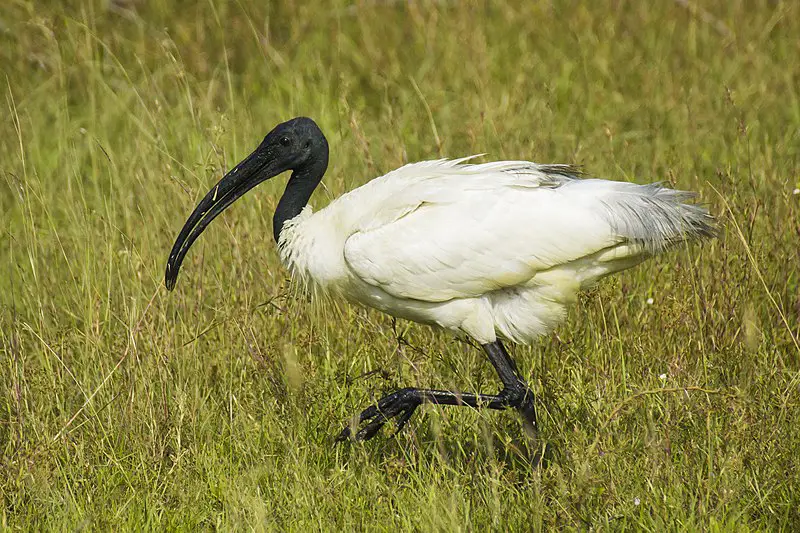
The Black-headed ibis is a majestic wading bird that can be found in areas of South and Southeast Asia, stretching from India to Japan.
It has an overall white plumage, with the most striking feature being its distinctive black neck.
These birds feed mainly on aquatic insects, small fish and frogs which they catch while walking slowly along shallow waters or sweeping their bill through them. They also eat worms, lizards and snails as well as some vegetation such fruits, grains etc..
Despite their wide range across different regions within South/Southeast Asia due to human activities like urbanisation and agricultural expansion.
This species’ population is decreasing at alarming rates making it critically endangered in certain parts of its natural habitat.Scientific classification:
| Kingdom | Animalia |
| Phylum | Chordata |
| Class | Aves |
| Order | Pelecaniformes |
| Family | Threskiornithidae |
| Genus | Threskiornis |
| Species | T. melanocephalus |
Also Featured In: Birds of Myanmar, Birds of Goa
14. Common Goldeneye
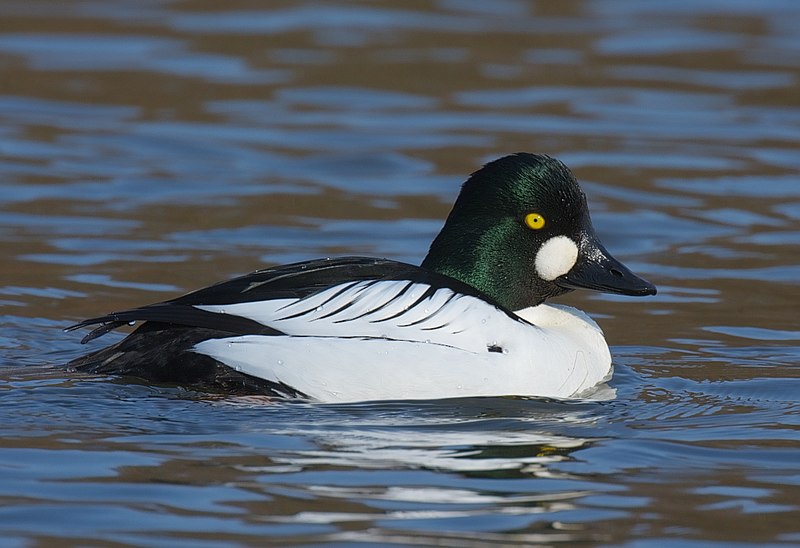
The Common Goldeneye is a medium-sized sea duck from the genus Bucephala. It has an iconic golden eye and bulbous head, which gave it its scientific name – Boukephalos (bullheaded).
This species can be found in many areas of North America, Europe and Asia. They are usually seen swimming alone or in pairs near large bodies of open water such as lakes and rivers.
In addition to their distinctive eyes, they have white wing patches on either side with black spots along the edges – helping them stand out among other ducks.
The diet of these birds includes aquatic insects, mollusks and crustaceans.
During mating season males often perform elaborate courtship displays including head bobbing while producing loud calls that can travel quite far distances across the landscape.Scientific classification:
| Kingdom | Animalia |
| Phylum | Chordata |
| Class | Aves |
| Order | Anseriformes |
| Family | Anatidae |
| Genus | Bucephala |
| Species | B. clangula |
Also Featured In: Birds of Poland, Common Birds in Alberta
15. Black Skimmer
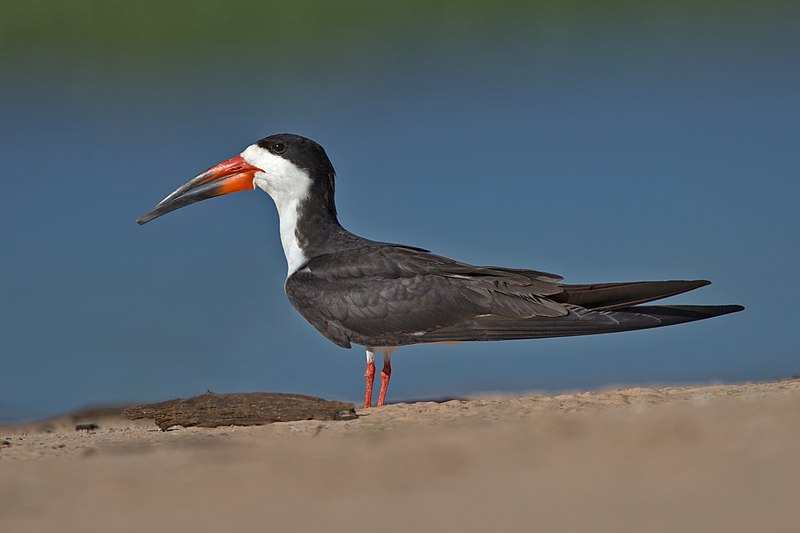
The Black Skimmer is a seabird which belongs to the skimmer genus Rynchops and Laridae family.
It breeds in North and South America, while Northern populations migrate south for winter towards warmer climates such as the Caribbean or Pacific coasts.
The Southern American races have adapted to annual floods by making shorter migrations during this time.
These birds are easily identified with their unique long red bill that has an upper mandible longer than its lower mandible.
They feed mainly on small fish caught at night when they skim across shallow water using their beak like a knife cutting through waves of water.
Their dark grey back contrasts against white belly feathers creating beautiful patterns in flight, aiding them in catching prey easier due to its camoflauge effect above and below waters surface.Scientific classification:
| Kingdom | Animalia |
| Phylum | Chordata |
| Class | Aves |
| Order | Charadriiformes |
| Family | Laridae |
| Genus | Rynchops |
| Species | R. niger |
Also Featured In: Most Unique Birds in Peru, Flight Birds You Should Know
16. Australian Magpie
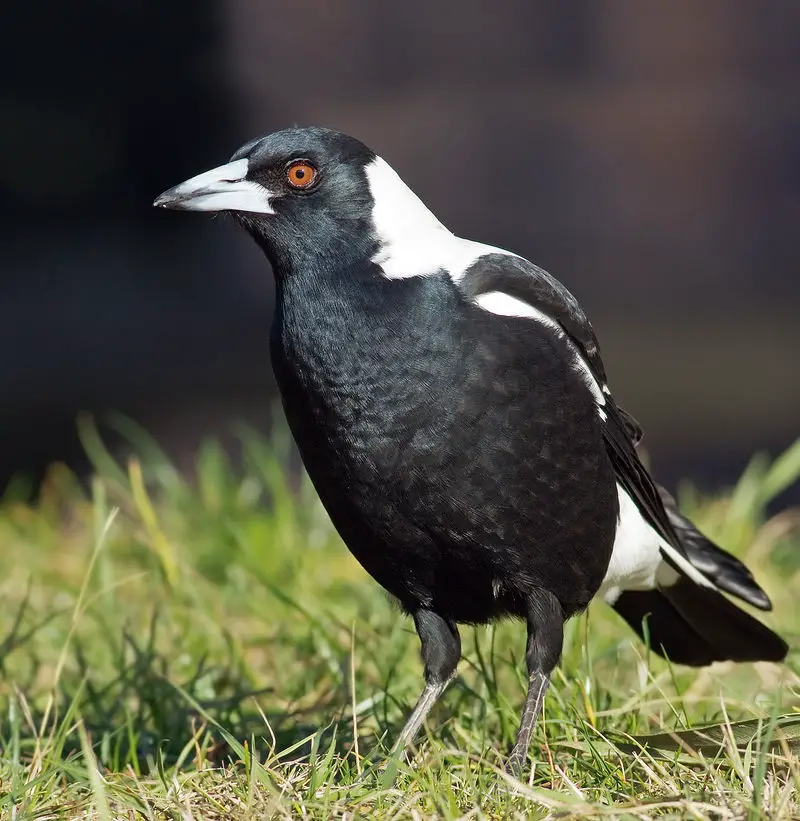
The Australian magpie is a beautiful passerine bird native to Australia and southern New Guinea.
It has distinctive black and white plumage, with males having more brightly coloured feathers than females.
The species is part of the Artamidae family, so it’s closely related to the Black Butcherbird (Melloria quoyi). Nine different subspecies have been recognised which vary slightly in size and colouring.
Magpies are omnivorous birds meaning they eat both plants and animals; their diet consists mainly of insects, small reptiles and amphibians as well as some grains such as wheat or oats.
They also enjoy drinking from pools of water on hot days. In general these birds display high intelligence when compared to other avian species – able to mimic human speech patterns quite accurately even in captivity.
Overall this majestic creature deserves our appreciation for its beauty, loyalty and fascinating behaviour.Scientific classification:
| Kingdom | Animalia |
| Phylum | Chordata |
| Class | Aves |
| Order | Passeriformes |
| Family | Artamidae |
| Genus | Gymnorhina Gray, GR, 1840 |
| Species | G. tibicen |
Also Featured In: Most common birds in Australia, Birds that Live around Brisbane
17. Oystercatchers
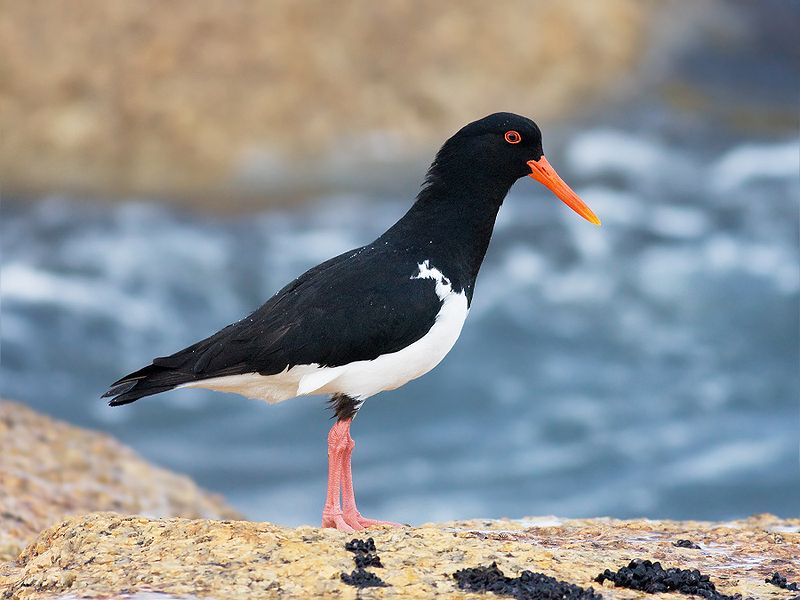
Oystercatchers are a family of waders forming the Haematopodidae, with one genus; Haematopus.
They live in coastal regions around the world excluding both polar and some tropical areas of Africa & South East Asia.
Eurasian, South Island & Magellanic oystercatcher species also breed far inland – breeding grounds being found much deeper than other members of the family.
They have long beaks used to feed on molluscs such as mussels, clams and oysters which they crack open using their strong bills.
Oystercatchers are usually quite vocal birds making various loud calls when disturbed or alarmed.
The males tend to display more brightly coloured plumage compared to females who share similar brown/black hues for camouflage purposes during nesting season.Scientific classification:
| Kingdom | Animalia |
| Phylum | Chordata |
| Class | Aves |
| Order | Charadriiformes |
| Suborder | Charadrii |
| Family | Haematopodidae Bonaparte, 1838 |
| Genus | Haematopus Linnaeus, 1758 |
Also Featured In: Best Birds Watching in Austria, Birds You’ll Find in Moldova
18. Razorbill
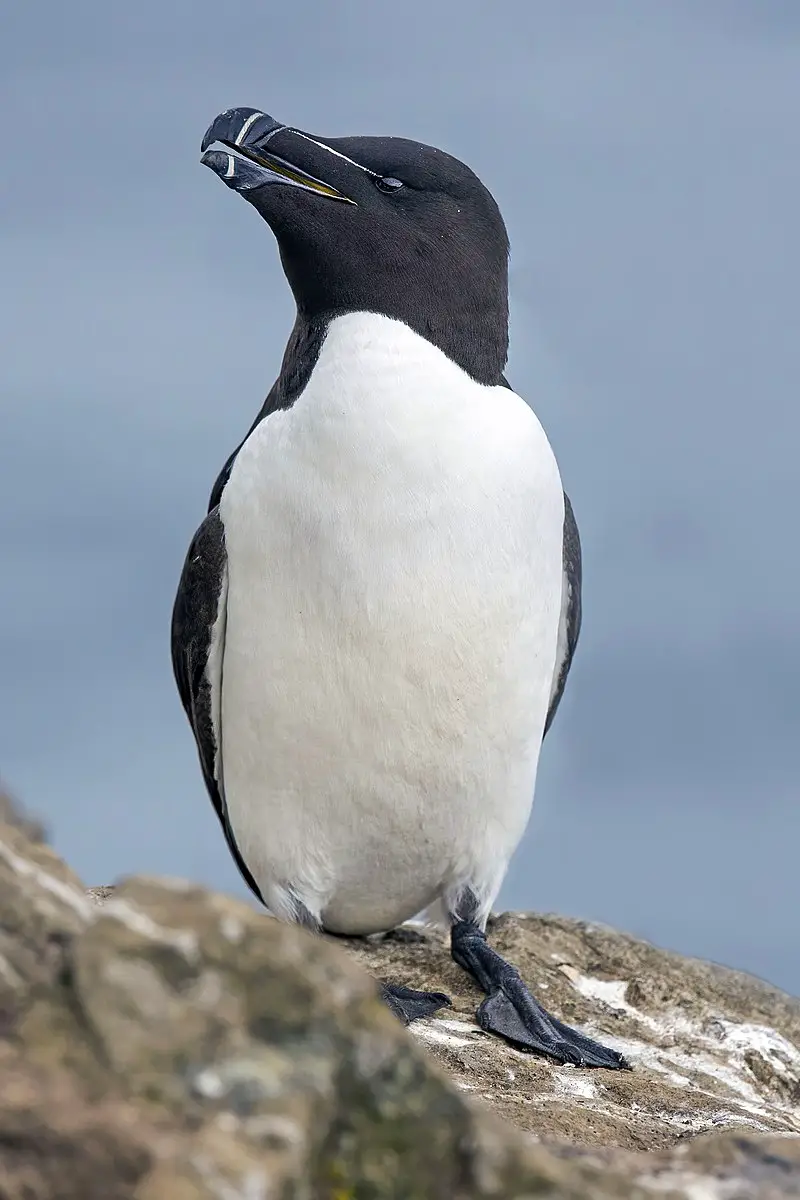
The Razorbill is a seabird of the family Alcidae and is closely related to the extinct great auk. It lives in subarctic waters of the Atlantic Ocean, primarily black with white underside and both male and female look identical.
They have long pointed wings which help them dive underwater for their food that consists mainly of fish and crustaceans.
Usually they form large colonies on cliffs or rocky islands but can also be found solitary during breeding season when pairs nest together in crevices or rock ledges near sea level.
During winter they migrate southwards into open water areas where they stay until spring arrives again before returning back to breed once more.
The razorbill’s population has been declining due to human activity such as overfishing so conservation efforts are being made by governments across Europe in order to protect this species from extinction.Scientific classification:
| Kingdom | Animalia |
| Phylum | Chordata |
| Class | Aves |
| Order | Charadriiformes |
| Family | Alcidae |
| Genus | Alca |
| Species | A. torda |
Also Featured In: Iceland birds, Birds that Live in the Ocean
19. Black Phoebe
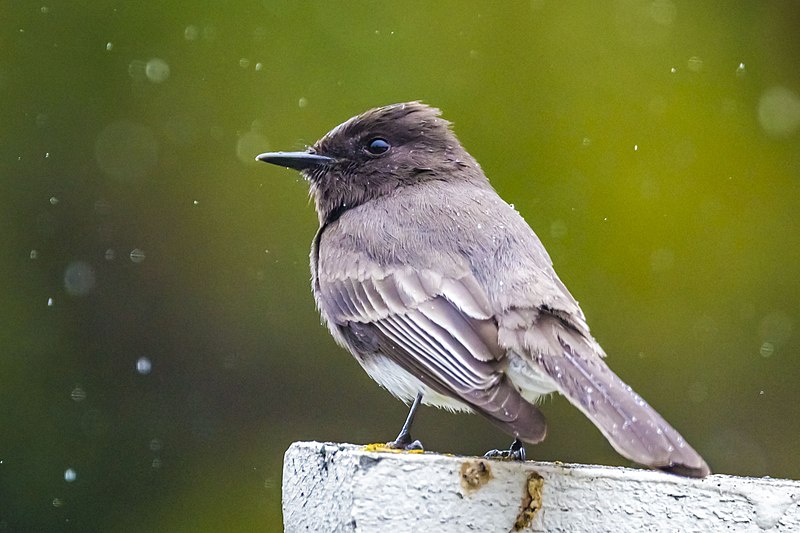
The black phoebe is a beautiful passerine bird belonging to the tyrant-flycatcher family. It breeds from southwest Oregon and California south through Central and South America, where it can be found year-round.
However, its northern populations tend to migrate seasonally in some areas. Six subspecies of this species have been identified so far: two are occasional visitors while the others are more common residents in their range.
The adult has mainly dark grey upperparts with a white belly; juveniles may show brownish tones instead of grey ones on their back.
Its main diet consists of insects which it catches by hovering over water or flying out after them from perches near rivers or streams – hence why they’re often seen around these places.Scientific classification:
| Kingdom | Animalia |
| Phylum | Chordata |
| Class | Aves |
| Order | Passeriformes |
| Family | Tyrannidae |
| Genus | Sayornis |
| Species | S. nigricans |
Also Featured In: Flycatchers Species, Birds Live Near San Diego
20. Black-And-White Warbler
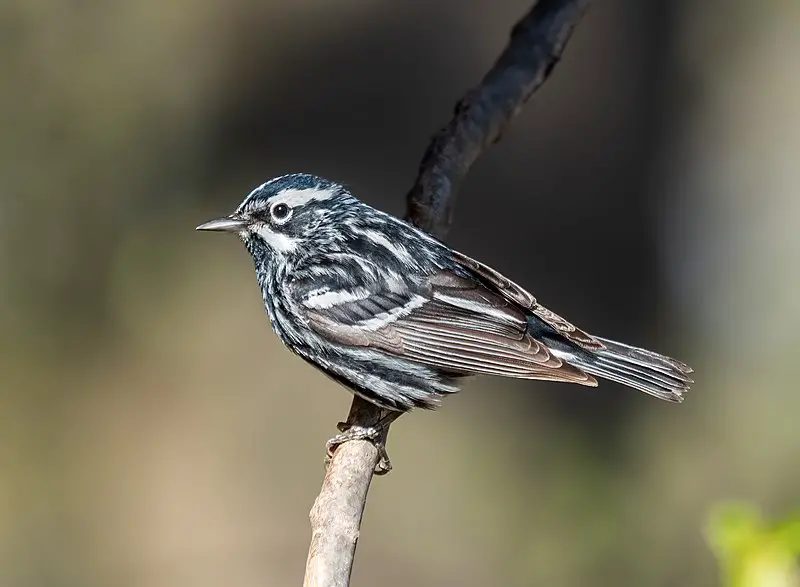
The Black-and-white Warbler is a unique species of bird native to North America. It has striking black and white plumage and breeds in the northern part of the continent, wintering in Central America, Florida, West Indies and Peru.
This warbler is rarely seen as far west as Europe but it’s still being studied for its behavior and ecology.
Its diet consists mainly of insects which it catches by clinging on trees like a woodpecker before quickly darting away again when prey appears.
The population size remains stable although they are vulnerable to habitat loss due to deforestation or other human activities so their conservation status should be monitored closely over time.Scientific classification:
| Kingdom | Animalia |
| Phylum | Chordata |
| Class | Aves |
| Order | Passeriformes |
| Family | Parulidae |
| Genus | Mniotilta Vieillot, 1816 |
| Species | M. varia |
Also Featured In: Nuthatches Species, Long Island Birds You Should Know
21. White-Crowned Sparrow
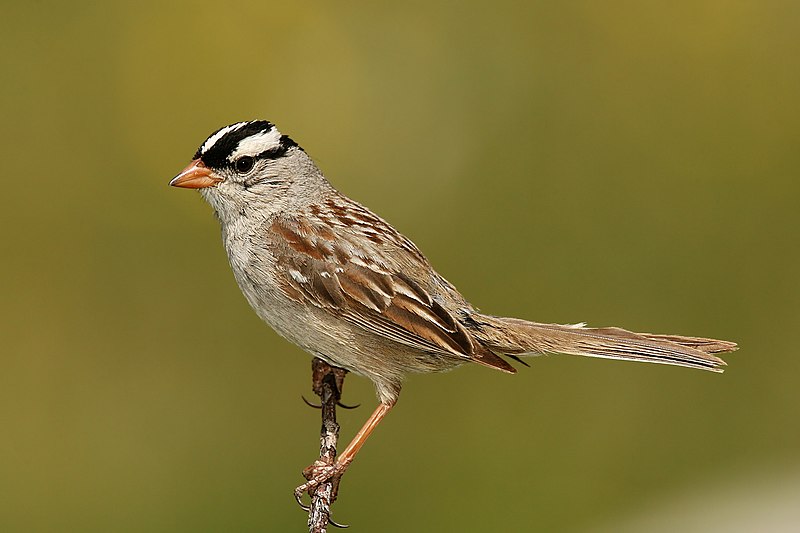
The White-crowned Sparrow is a species of passerine bird native to North America. It has a grey face and black and white streaking on its upper head, making it easy to identify.
This sparrow usually breeds in brushy areas located in the taiga, tundra, Rocky Mountains or Pacific coast regions of North America.
During winter months these birds migrate southward as far as Mexico and California where they can be found living amongst chaparral shrubbery or low bushes near open fields with plenty of seeds nearby.
The diet of this bird consists mainly of insects during summer while they switch over to eating grains like wheat & oats during colder months when bugs are scarce.
They are known for their characteristic chirp which sounds like “Oh sweet Canada Canada” drawing admirers from around the world.Scientific classification:
| Kingdom | Animalia |
| Phylum | Chordata |
| Class | Aves |
| Order | Passeriformes |
| Family | Passerellidae |
| Genus | Zonotrichia |
| Species | Z. leucophrys |
Also Featured In: Sparrows Species, Most Common Songs Birds that Live around You
22. Lark Bunting
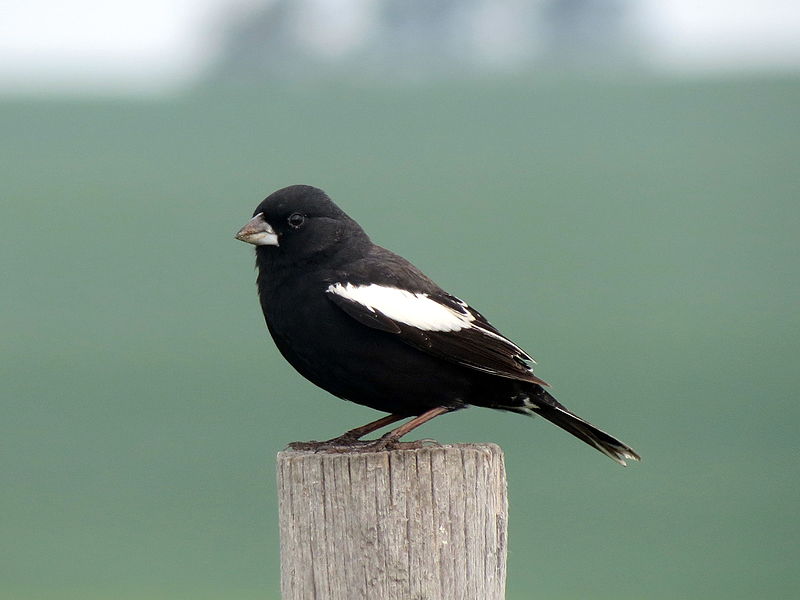
The Lark Bunting is a medium-sized sparrow native to central and western North America. It was designated the state bird of Colorado in 1931, making it an important part of local culture.
The species is monotypic; meaning it’s not related to any other genera out there.
J.K Townsend first described this fascinating bird back in 1837 after finding a specimen during his travels with Major Stephen H Long on their expedition up the Platte River valley through Nebraska and Wyoming into South Dakota.
This friendly little creature has black feathers at its crown, grey wings and tail, white breast streaked with black patches – all contributing together to create one colorful picture.
Its habitat ranges from grasslands across prairies as well as cultivated farms where they usually nest low down on ground level or within shrubs for safety purposes.
With such beautiful features along with its cheerful chirps that can be heard throughout springtime mornings, no wonder why this majestic avian holds so many admirers amongst nature lovers everywhere.Scientific classification:
| Kingdom | Animalia |
| Phylum | Chordata |
| Class | Aves |
| Order | Passeriformes |
| Family | Passerellidae |
| Genus | Calamospiza Bonaparte, 1838 |
| Species | C. melanocorys |
Also Featured In: Birds That Live in Colorado, Birds that Live in the Grasslands
23. Tree Swallow
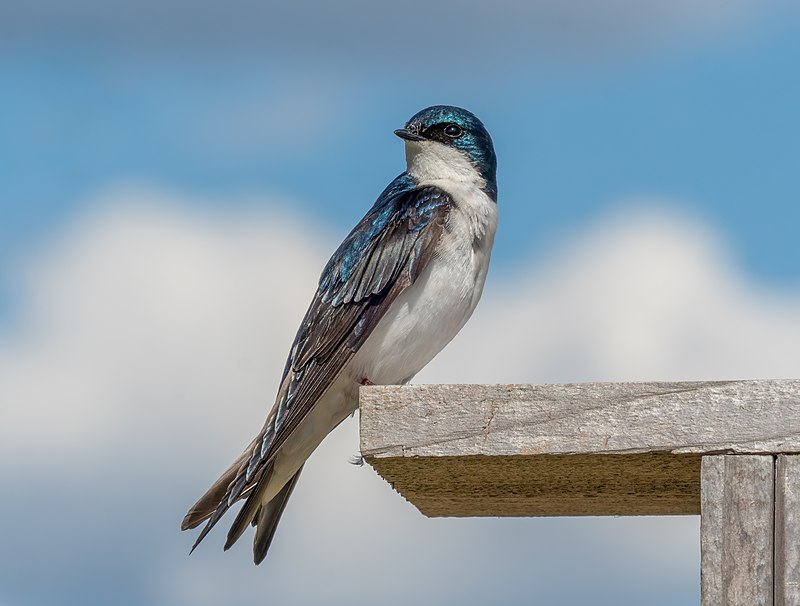
The Tree Swallow is a migratory bird of the Hirundinidae family, first described by French ornithologist Louis Vieillot in 1807. It has glossy blue-green upperparts, and white underparts with iridescent violet on its throat and breast.
Its wings are blackish above with pale grey below, while its tail feathers are blackish-blue with white edges.
During breeding season they build cup shaped nests out of grasses or twigs which are lined with animal hair or fur found near their nesting sites.
They feed mainly on insects such as flies and beetles that they catch while flying over fields or water surfaces during summer months when food is abundant for them to survive migration back southward in winter time.
The tree swallow is an important part of our environment both aesthetically and ecologically due to it’s insectivorous diet helping keep pest populations low in certain areas where agricultural crops may otherwise be damaged without these birds around.Scientific classification:
| Kingdom | Animalia |
| Phylum | Chordata |
| Class | Aves |
| Order | Passeriformes |
| Family | Hirundinidae |
| Genus | Tachycineta |
| Species | T. bicolor |
Also Featured In: Swallows Species, Blue Birds You’ll Found around Us
24. Yellow-Bellied Sapsucker
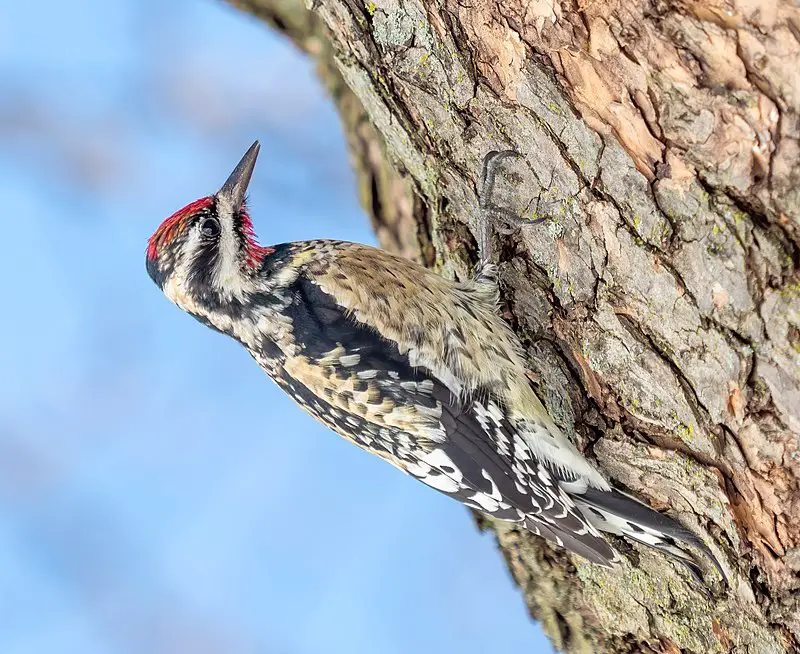
The Yellow-bellied Sapsucker is a medium sized woodpecker that can be found in Canada and the northeastern United States.
It was first described by English naturalist Mark Catesby who illustrated it with hand coloured plates for his book The Natural History of Carolina, Florida and the Bahama Islands during 1729 -1732.
This beautiful bird has white stripes on its black head which contrast against its yellow throat, breast and belly making it stand out from other birds. Its wings are barred with red patches adding to their beauty.
They also have white streaks on their sides along with bold spots at their back giving them an unique look among others.Scientific classification:
| Kingdom | Animalia |
| Phylum | Chordata |
| Class | Aves |
| Order | Piciformes |
| Family | Picidae |
| Genus | Sphyrapicus |
| Species | S. varius |
Also Featured In: Woodpeckers Species, Yellow Birds You’ll Find in North Carolina
25. White-Tailed Kite
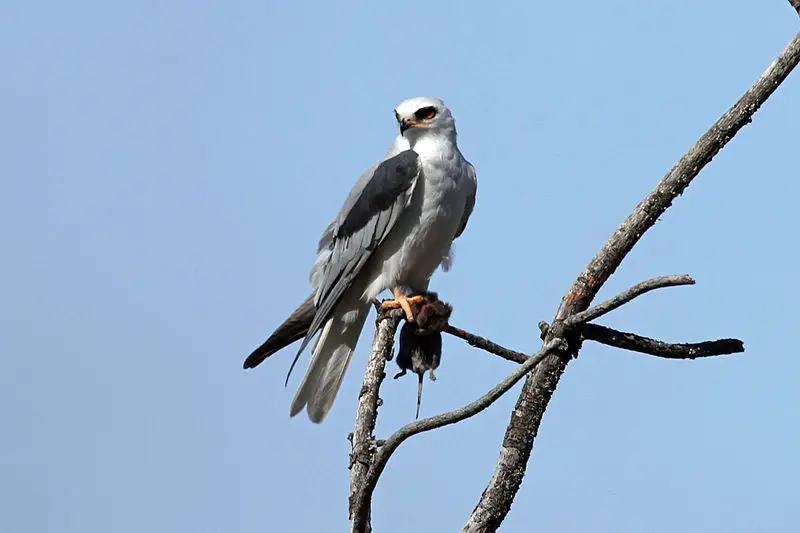
The White-tailed Kite is a small raptor found in western North America and parts of South America. It was first described by French ornithologist Louis Jean Pierre Vieillot in 1818, with the type locality being Paraguay.
This species belongs to the same family as Old World black-winged kites, but is more widespread than its relative.
They are recognized easily due to their distinct white heads and tails, grey wings and backs, yellow eyes and legs.
Theses birds primarily hunt for rodents such as mice during daylight hours using their exceptional hunting skills like hovering midair before diving down on prey or swooping low over grasslands looking for food items on the ground.
In addition they also feed upon insects including grasshoppers and locusts which provides them additional nutrition throughout summer months.Scientific classification:
| Kingdom | Animalia |
| Phylum | Chordata |
| Class | Aves |
| Order | Accipitriformes |
| Family | Accipitridae |
| Genus | Elanus |
| Species | E. leucurus |
Also Featured In: Common Californian Birds, Common Southern Californian Birds
26. Black-Billed Magpie
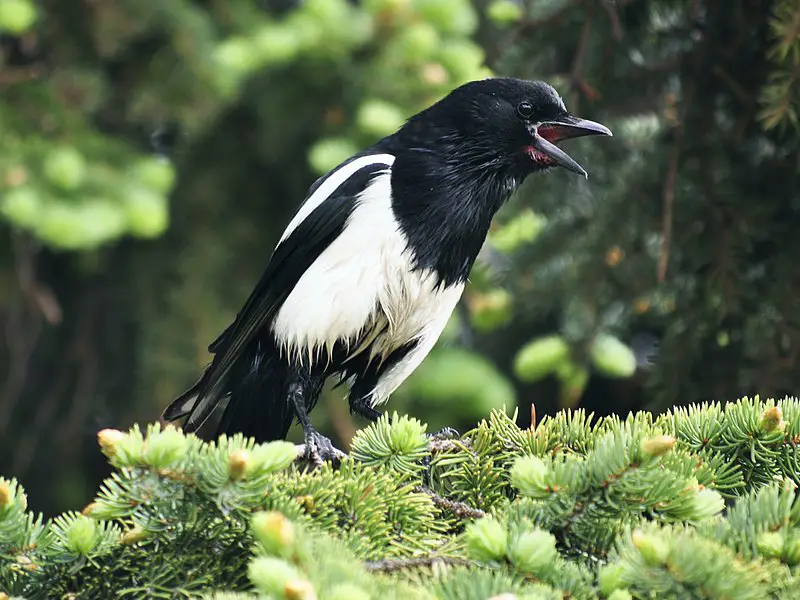
The black-billed magpie is an iconic bird of the western half of North America and one of only four songbirds with a tail that makes up over half its body length.
With its glossy black feathers offset by white patches, they can be seen in open woodlands or near agricultural areas.
Their diet consists mainly of insects, carrion and grains but they often scavenge human food as well.
They are highly social birds who live in large groups and communicate through loud calls, snaps and rattles when defending their territory from other airborne predators like hawks or eagles.
Magpies have proven to be hardy survivors despite habitat loss due to urbanization so there’s hope these remarkable birds will remain part our landscape for many years to come.Scientific classification:
| Kingdom | Animalia |
| Phylum | Chordata |
| Class | Aves |
| Order | Passeriformes |
| Family | Corvidae |
| Genus | Pica |
| Species | P. hudsonia |
Also Featured In: Utah Birds, Birds that Found in the Yellowstone
27. Rose-Breasted Grosbeak
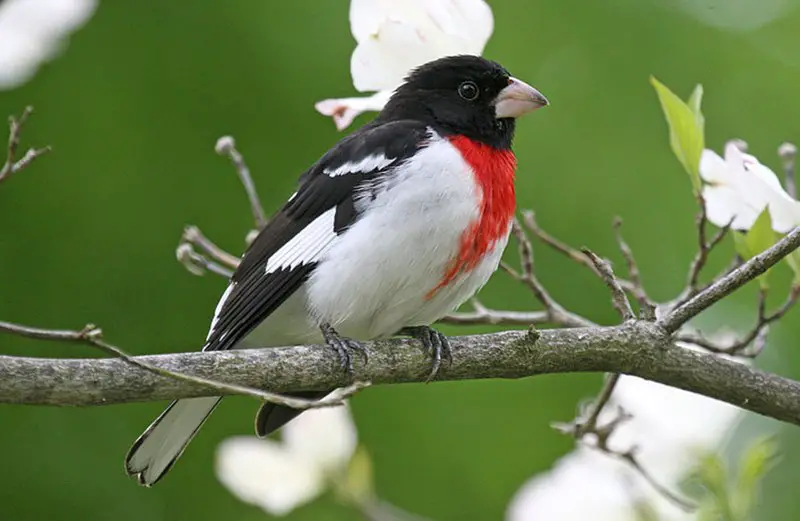
The Rose-breasted Grosbeak is a large, brightly coloured bird belonging to the Cardinal family. Males have black heads and wings, with white breasts boasting a bright rose patch.
Females are more muted in colouring being mostly buffy brown or greyish overall but still featuring the distinctive rose breast patch.The two sexes also exhibit marked sexual dimorphism.
These birds inhabit open woodlands across North America where they feed on seeds gleaned from foliage as well as fruits such as cherries and blueberries during their breeding season which runs from April through August each year.Scientific classification:
| Kingdom | Animalia |
| Phylum | Chordata |
| Class | Aves |
| Order | Passeriformes |
| Family | Cardinalidae |
| Genus | Pheucticus |
| Species | P. ludovicianus |
Also Featured In: Nebraska Birds, New Hampshire Birds You Should Know
28. Blackpoll Warbler
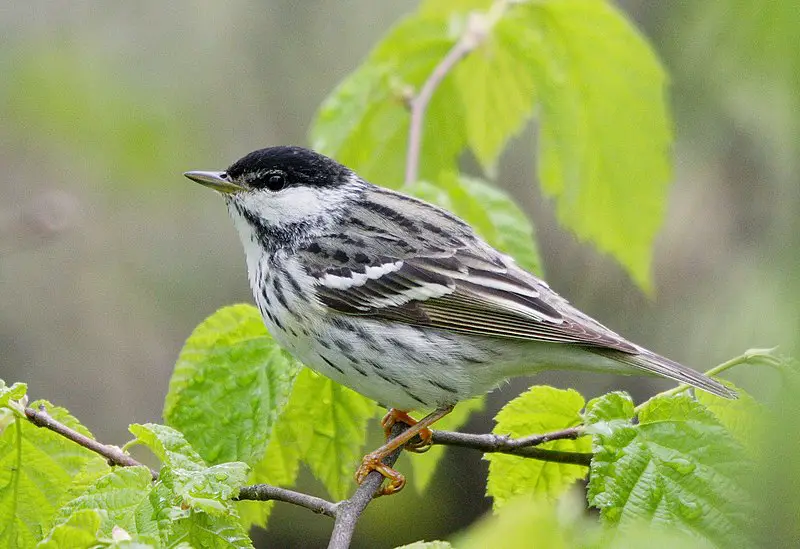
The Blackpoll Warbler is an impressive and beautiful bird. It has a black cap, white cheeks and white wing bars.
During the breeding season it can be found in forests of northern North America from Alaska through Canada to the mountains of New York and New England.
In fall they migrate south, sometimes travelling over 3,000 miles non-stop – one record was set for 75 hours.
They are very adaptable birds but their numbers have been declining due to habitat destruction so conservation efforts must remain ongoing if we want these amazing creatures around forevermore.Scientific classification:
| Kingdom | Animalia |
| Phylum | Chordata |
| Class | Aves |
| Order | Passeriformes |
| Family | Parulidae |
| Genus | Setophaga |
| Species | S. striata |
Also Featured In: Pennsylvania Birds, Mountain Birds You Should Know
29. New World Orioles
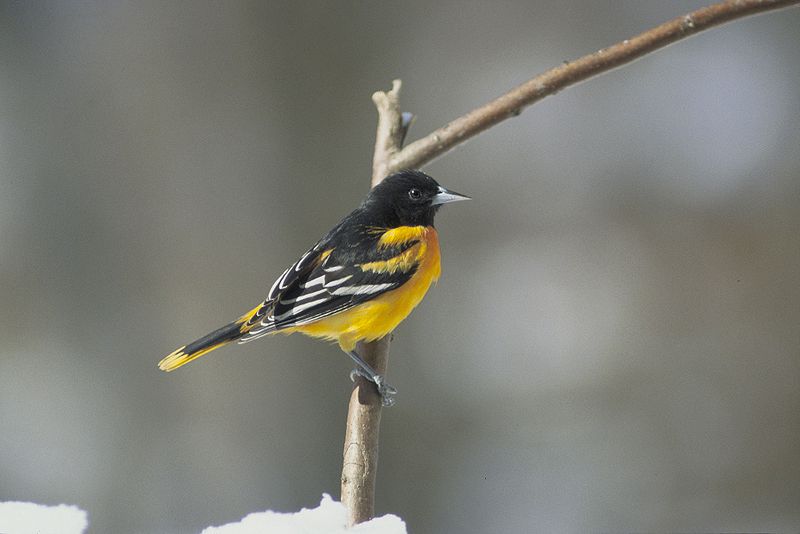
New World orioles are a group of birds belonging to the blackbird family. They share many features with Old World orioles, including size, diet and behaviour; however they differ in their striking plumage.
Males have bright yellow or orange bodies with contrasting black wings and white markings on the head and breast.
Females and immature birds tend to be duller colours such as browns and greys. These colourful songbirds feed primarily on fruit, insects, nectar from flowers or sap from trees – sometimes even raiding other nests for eggs.
Their cheerful chirps can often be heard throughout parks during summertime months.Scientific classification:
| Kingdom | Animalia |
| Phylum | Chordata |
| Class | Aves |
| Order | Passeriformes |
| Family | Icteridae |
| Genus | Icterus Brisson, 1760 |
Also Featured In: Louisiana Birds, Summer Birds that Live around Us
30. Black-Throated Gray Warbler
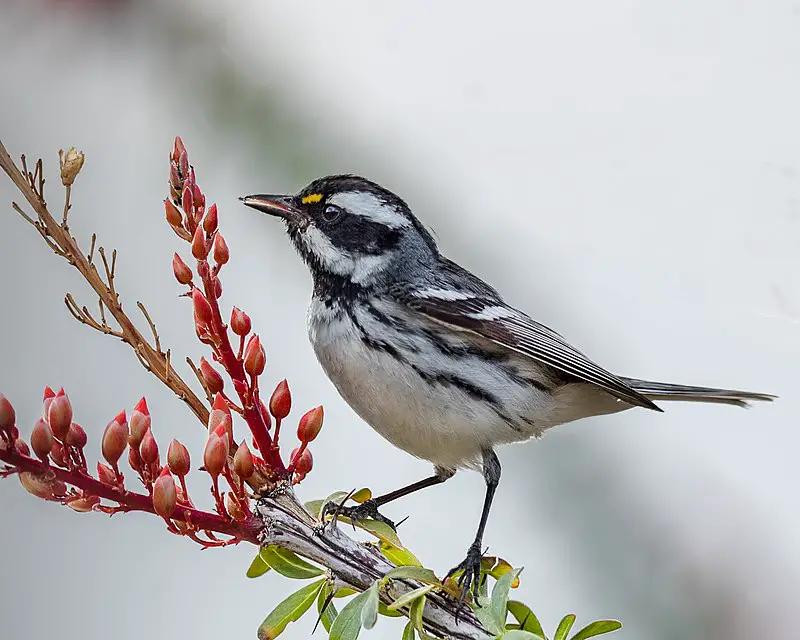
The Black-throated Gray Warbler is a species of New World warbler belonging to the Parulidae family. It measures 13 cm in length, and has gray and white plumage with distinct black markings.
Males have bold black throats, along with black stripes on their heads and streaks on their flanks; females are paler versions of males, but still feature similar coloration patterns.
These birds breed throughout western North America from Alaska to Mexico during summer months before migrating southwards for wintertime.
The Black-throated Gray Warblers typically inhabit coniferous forests near rivers or streams where they forage for insects among foliage by gleaning or hovering briefly over branches.
They have also been known to feed upon berries when available as well as nectar during migration periods.Scientific classification:
| Kingdom | Animalia |
| Phylum | Chordata |
| Class | Aves |
| Order | Passeriformes |
| Family | Parulidae |
| Genus | Setophaga |
| Species | S. nigrescens |
Also Featured In: birds of gray, Birds You’ll Find in Vancouver Island
31. Eurasian Magpie
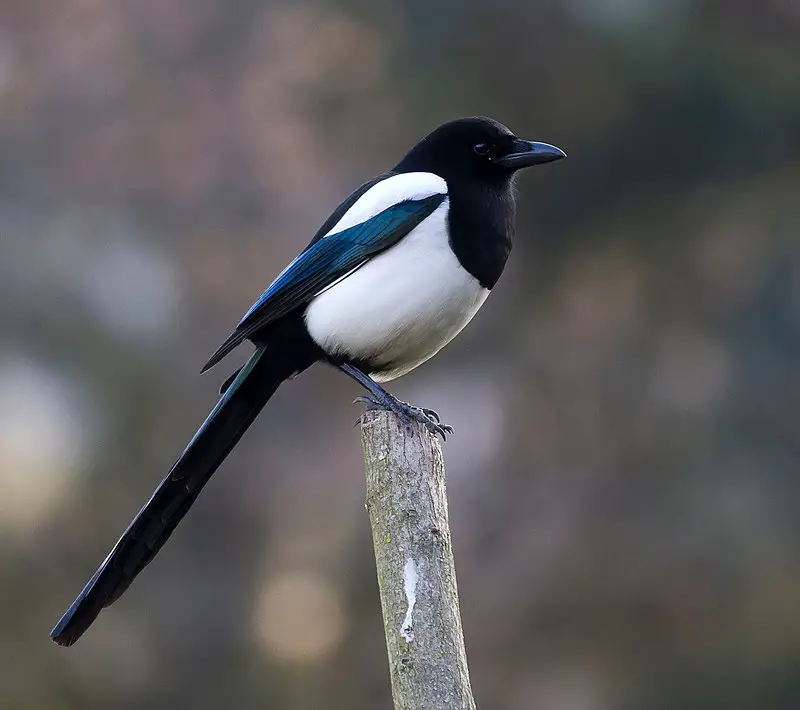
The Eurasian magpie, also known as the common magpie, is a bird found in the northern part of the Eurasian continent. It belongs to the corvids family and is part of the “monochrome” magpies.
The bird is a resident breeder that is always available in Europe. The only other magpie found in Europe is the Iberian magpie.
The magpie is often used as a synonym for the Eurasian magpie by English speakers.
The bird has a distinct black and white appearance and is known for its intelligent behavior. It can imitate sounds heard in its environment and also demonstrates self-awareness.
The Eurasian magpie is omnivorous and feeds on insects, small mammals, and fruits.
It forms monogamous pairs that last for a lifetime and builds nests in trees or bushes. The bird is not endangered and is often regarded as a nuisance due to its habit of raiding gardens for food.Scientific classification:
| Kingdom | Animalia |
| Phylum | Chordata |
| Class | Aves |
| Order | Passeriformes |
| Family | Corvidae |
| Genus | Pica |
| Species | P. pica |
Also Featured In: Ukrainian Birds You Should Know, Common Estonian Birds
32. Accipitriformes
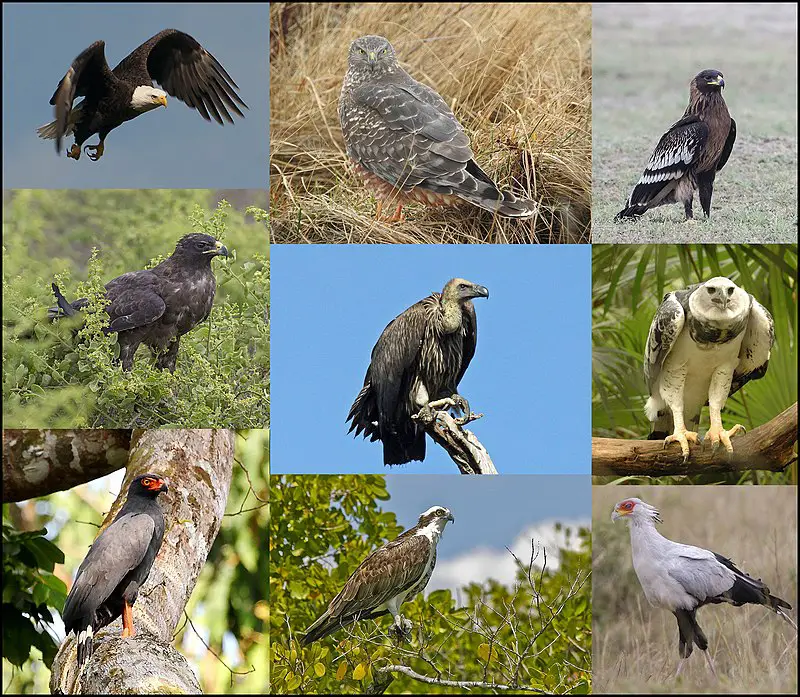
The Accipitriformes are a diverse and powerful group of birds of prey, consisting of hawks, eagles, vultures, and kites.
While they share physical and behavioral characteristics with falcons, they are now recognized as a separate order of birds.
They are primarily diurnal or crepuscular, meaning they are active during the day or at dawn and dusk.
Members of this order have sharp, hooked beaks to tear apart their prey, and powerful talons to catch and hold onto their prey.
Many species exhibit impressive hunting abilities, with keen eyesight and swift flight.
Accipitriformes play an important role in controlling populations of smaller animals such as rodents and birds, and some species are apex predators in their ecosystems.
They are found across the globe, inhabiting diverse environments from grasslands to mountains to forests.Scientific classification:
| Kingdom | Animalia |
| Phylum | Chordata |
| Class | Aves |
| Clade | Accipitrimorphae |
| Order | Accipitriformes Vieillot, 1816 |
Also Featured In: Large African Birds You Need to Know,
33. Pied Avocet
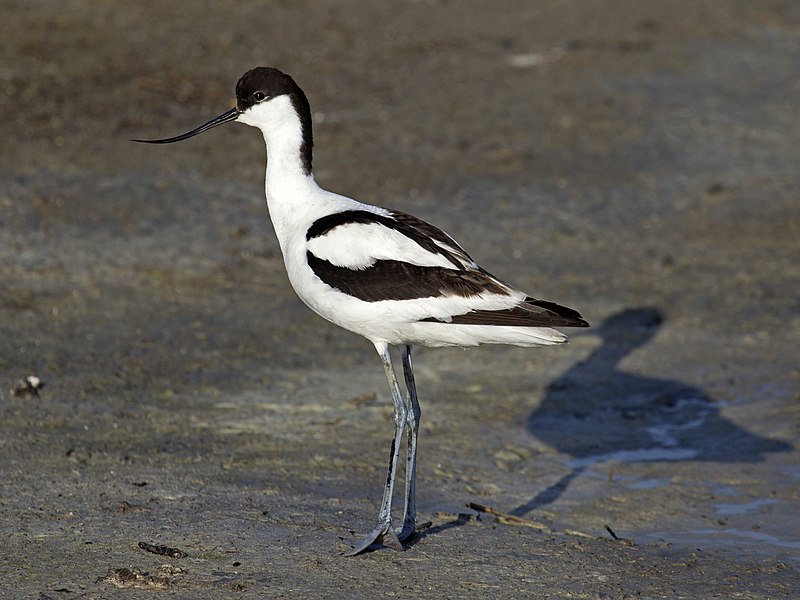
The pied avocet is a distinctive wader bird, easily recognized by its black and white plumage and upturned bill.
Found in temperate Europe and the Palearctic region, these birds migrate to Africa or southern Asia for the winter.
However, some of them can stay in the southern part of their breeding range. These birds are known for their distinctive feeding behavior, where they sweep their bills side to side through shallow water to locate prey.
They mainly feed on aquatic invertebrates, such as insects and crustaceans.
The pied avocet can be found in a range of wetland habitats, including coastal lagoons, estuaries, and shallow lakes.
They breed in colonies and make nests on the ground, which are often located on islands or raised mounds.
These birds are considered to be of least concern for conservation, although habitat loss and disturbance can pose a threat to their populations.Scientific classification:
| Kingdom | Animalia |
| Phylum | Chordata |
| Class | Aves |
| Order | Charadriiformes |
| Family | Recurvirostridae |
| Genus | Recurvirostra |
| Species | R. avosetta |
Also Featured In: Hong Kong Birds You Need to See, Common Birds of Lesbos Island
34. White-Browed Wagtail
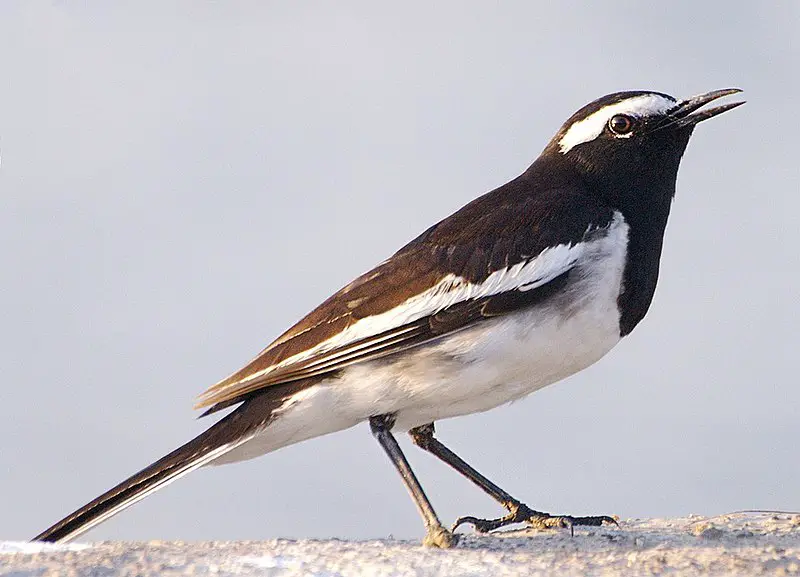
The White-browed wagtail, also known as the large pied wagtail or Motacilla maderaspatensis, is a medium-sized bird belonging to the wagtail family.
This bird boasts a striking black and white pattern, with black feathers above and white feathers below.
It also features a white brow, shoulder stripe, and outer tail feathers. The White-browed wagtail can be commonly found near small bodies of water in South Asia and has adapted well to living in urban environments.
As the largest member of its family, this bird is a magnificent sight to behold, often spotted flitting about rapidly by the water’s edge.Scientific classification:
| Kingdom | Animalia |
| Phylum | Chordata |
| Class | Aves |
| Order | Passeriformes |
| Family | Motacillidae |
| Genus | Motacilla |
| Species | M. maderaspatensis |
Also Featured In: Delhi Birds You Need to See, Common Birds in Bangalore